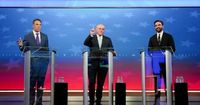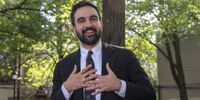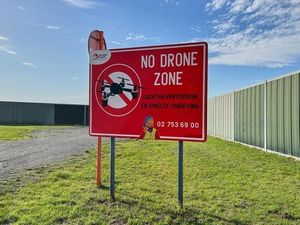The race for New York City’s mayoralty has reached a fever pitch, with just days remaining before early voting begins and a trio of candidates locked in a high-stakes, high-drama contest. At the center of the storm: Zohran Mamdani, the Democratic Socialist assemblyman leading in the polls; Andrew Cuomo, the embattled former governor running as an independent; and Curtis Sliwa, the perennial Republican outsider whose candidacy has become the subject of fierce debate and political intrigue.
According to a new poll released by AARP and Gotham Polling and reported by CBS News New York on October 21, 2025, Mamdani holds a commanding lead with 43.2% of likely voters, while Cuomo trails at 28.9%. Sliwa, the founder of the Guardian Angels and a familiar face in city politics, sits in third place with 19.4%. The race, entering its final phase, is set against a backdrop of looming public health crises, deep federal funding cuts, and an electorate hungry for change.
The Republican Party, for its part, has thrown its full weight behind Sliwa, with the leaders of all five New York City counties issuing a joint statement reaffirming their “unequivocal support” for his campaign. “Republicans across every borough stand united behind Curtis Sliwa for Mayor of New York City,” the county chairs declared, citing “overwhelming grassroots momentum, record petitioning and citywide support built from the ground up.” The five county leaders—Richmond County Chair Assembly Member Michael Tannousis, New York County Chair Andrea Catsimatidis, Bronx County Chair Michael Rendino, Queens County Chair Anthony Nunziato, and Kings County Chair Liam McCabe—emphasized the genuine, volunteer-driven nature of Sliwa’s campaign, describing it as “proof of a genuine grassroots movement that money cannot manufacture.”
Yet, not everyone in the city’s political establishment is convinced. The editorial board of The New York Post issued a pointed opinion on October 20, 2025, urging Sliwa to face reality and step aside for the good of the city. “It’s time for Curtis Sliwa to face reality, and admit that the city’s best hope to avoid the disaster of a Zohran Mamdani mayoralty is for him to drop out of the race,” the board wrote. The editorial was blunt: Sliwa is “far back in third place in every poll, with zero chance of winning.” Their argument was tactical—polling showed that if Sliwa were to withdraw, Cuomo would be within striking distance of Mamdani, potentially closing the gap to just four percentage points, well within the poll’s margin of error.
The numbers bear out the editorial’s logic. Should Sliwa exit the race, the AARP/Gotham Polling data suggests Mamdani’s lead would shrink to 44.6%, with Cuomo surging to 40.7%. That’s a razor-thin margin in a city known for its political volatility. The editorial board acknowledged Sliwa’s hard work and the energy of his campaign, but questioned his experience and the viability of his candidacy, noting his “sometimes-shady past and zero experience relevant to running the behemoth that is city government.”
Sliwa, for his part, has remained defiant. “I’m not dropping out,” he declared on October 21, 2025, in response to mounting pressure from both the press and rival campaigns. “One person, one vote. That’s how we determine elections. I never heard a caveat that said one person, one vote, and of course others need to drop out along the way.” His message is clear: he intends to see the race through to the end, regardless of the political calculus swirling around him.
Cuomo’s position has shifted over the course of the campaign. Last week, he lamented that Sliwa’s continued presence in the race was a hindrance to defeating Mamdani. But by Monday morning, October 20, 2025, Cuomo had shifted his rhetoric, telling Fox News that Sliwa was “irrelevant.” “He does take a certain number of votes, and to that extent, he is a spoiler. I believe he’s, ultimately, irrelevant, because he’s not a viable candidate and I don’t think people are gonna throw away their vote,” Cuomo said. The former governor’s campaign is betting that voters will coalesce behind him as the only viable alternative to Mamdani in the race’s closing days.
Mamdani, meanwhile, has welcomed the crowded field, framing Sliwa’s participation as a victory for democratic choice. “It’s genuinely positive for our democracy that there’s another candidate in this race who believes New York City voters should pick their next mayor, not billionaires who mostly live somewhere else,” Mamdani said. He has also criticized Cuomo for focusing on other candidates rather than directly addressing voters’ concerns. “We are spending this time speaking directly to New Yorkers. Andrew Cuomo is spending it speaking about the other candidates.”
At stake in this election are monumental challenges. As Healthbeat reported on October 21, 2025, the next mayor will inherit a city facing deep cuts to Medicaid and food assistance, aging and flood-prone infrastructure, and the potential loss of health insurance for 600,000 residents. The New York City Department of Health and Mental Hygiene, with its $1.6 billion budget and 7,000 employees, will be tasked with responding to these threats even as the White House dismantles key federal agencies. “The stakes are enormously high,” said Diana Silver, professor of public health policy and management at New York University.
The candidates’ approaches to these issues differ. Mamdani, 34, proposes creating a corps of outreach workers to help New Yorkers navigate the health care system and a Department of Community Safety to send mental health professionals, not police, to respond to crises. Cuomo, 67, has put forward a $2.6 billion plan to expand housing for adults with serious mental illness or substance use disorders. Both acknowledge the need to address mental health, but neither campaign has provided detailed health policy plans. Sliwa’s campaign, notably, does not list health issues among its platform priorities.
Relations with Albany will also be crucial, given the likelihood of federal funding shortfalls. Governor Kathy Hochul endorsed Mamdani in September, writing in The New York Times that she is “confident that [Mamdani] has the courage, urgency, and optimism New York City needs to lead it through the challenges of this moment.” Cuomo insists he has a good relationship with the governor and touts his experience dealing with President Donald Trump, claiming, “I got more help for New York from Trump than anyone expected.” Mamdani, in contrast, has said he will stand up to Trump, who has threatened to withhold funding if Mamdani is elected.
Cuomo’s tenure as governor remains a topic of debate. While he was praised early in the pandemic for his calm leadership, he later faced criticism and a federal investigation for undercounting Covid-related nursing home deaths. He resigned in 2021 after a report concluded he had sexually harassed at least 11 women, a charge he denies.
With the next debate set for October 22, early voting beginning October 26, and Election Day on November 4, the city’s future hangs in the balance. As the candidates prepare for their final showdown, New Yorkers are left to weigh their choices carefully—knowing that the stakes, and the consequences, have rarely been higher.






